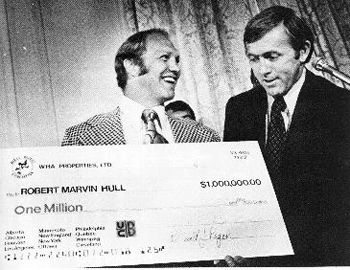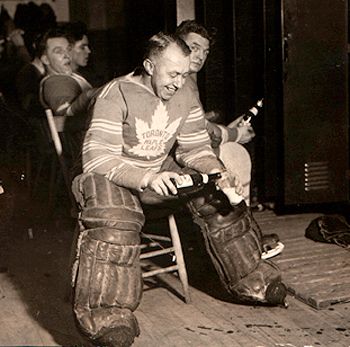as he scores in Game 7 against Vancouver
the puck stuck in the leg of his pants!
The Hockey Jersey of the Day Blog




Let's not forget the shot that was heard around the world. Well, maybe just the hockey world. Allan Thomas Reid was not a prolific scorer among NHL defensemen. In a span of 10 shin-bruising seasons with the North Stars, Tall Tommy scored only 17 goals, but on the night of October 14, 1971, he performed a feat that put him in a class by himself and earned him a place in the team history book. On one of his rare good scoring opportunities, Reid was fouled by a Montreal player and the referee awarded him a penalty shot.Coach Jack Gordon, showing supreme confidence in Reid's scoring prowess, asked the ref, "Does Reid have to take the shot?" To young Thomas that was the ultimate insult, but take the shot he did. Unleashing all of his anger over the coach's lack of confidence, Reid launched a blistering rocket that left Ken Dryden trembling in his skates. The twine behind Dryden bulged, the red light flashed, bells chimed, fireworks filled the air, brass bands started playing, an thousands of fans began chanting, "Tommy! Tommy! Tommy!" And so, a hero was born on that autumn evening, many years ago.
I came out of the penalty box and was heading toward the bench when a clearing pass hit my skate and careened toward the Montreal zone. Instead of going to the bench I went after the puck and had a clear breakaway. Guy Lapointe tripped me from behind and I slid hard into the boards.Referee Bruce Hood skated over and asked if I was okay. I said "Yes," and then, "You're giving him a penalty, right?" He said, "You're getting a penalty shot." I said: "Bruce, go to hell. I don't want a penalty shot." "You got one," he replied.When I got to the bench, coach Jack Gordon asked what was going on. Hood skated over and said, "Let's go." Jack said, "What do you mean?" and was then informed of the penalty shot. Jack said, "Does he have to take the shot?" and I informed Hood that I thought my leg was broken. Hood said, "Let's go or you'll get a delay of game."Everyone on the bench was giving me advice about what to do with the shot, but J. P. Parise simply said, "Put the damn thing behind him."I was so focused as I got ready to take the puck that I couldn't hear a thing. There were 15,000 people in the building, but I heard nothing. It was a warm October night so the ice was a bit wet, and I was worried about carrying the puck across the blue line. My main concern was just getting off a shot.I skated in, got to the high slot, and shot the puck. Ken Dryden wasn't expecting a shot that quickly and he overreacted. I was aiming for the corner, but the puck went between his legs and into the net, my big claim to fame.When I got back to the bench, I said to Jack, "Was there ever any doubt?"
Tom Reid was a terrific defensive defenseman. He was very consisent - game in and game out you knew you going to get strong defense from Tommy. His play never varied.I had three concussions in my career. The third one was the result of a real good check by Dennis Owchar one night in Pittsburgh. At the doctor's suggestion, I had started wearing a helmet after my second concussion to help prevent further ones.But this night in Pittsburgh I was playing defense with Tom Reid, and I was carrying the puck up the ice. I thought I had made a real good move to get by Owchar, but as I slipped the puck though his legs to try to go around him, he hit me with a shoulder right between my shoulder blades and I went down very hard. I hit my head on the ice so hard I eventually had seven stitches, even with the helmet.I tired to get up, was real dizzy and started going back down again. The next thing I know, the trainer, Doc Rose, is on the ice telling me to lie down, that they're going to carry me off.I said, "There's no way. I've never been carried off the ice, and I'm not going to let anybody carry me off now."I tried to get up again, and I went right back down. And as I'm going down this time, Tom Reid leans over and says. "Louie, Louie, before you go, can I have your condominium in Florida?"

Looking to reach our loyal readers with your hockey related product or service? Of our hundreds of readers each day, 60% are located in the United States and 30% come from Canada. Our audience is your audience and you can target them now with our reasonable ad rates.
We've been linked to by SI.com, ESPN.com, Uni-Watch.com, NBCSports.com and the Yahoo! Sports Puck Daddy blog among others.
Contact us today for more information at: Spyboy1@gmail.com!

There is no limitation to what kind of hockey jersey it can be - replica, authentic or game worn jersey from the NHL, a national team, the minors, juniors, college, high school or even your pond hockey jersey.
To submit your jersey, just send an email to Spyboy1@gmail.com